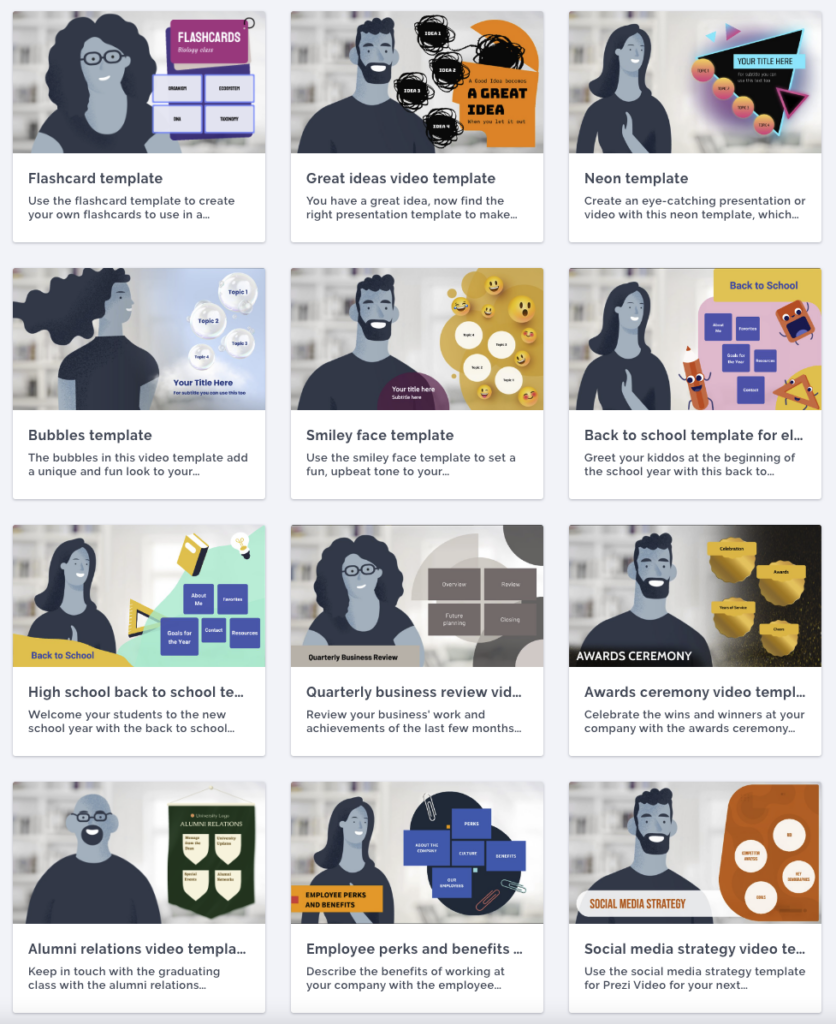In today’s fast-paced world, where technology connects people across the globe, the traditional methods of learning and training have evolved. Online training has emerged as a powerful tool, offering individuals and businesses the flexibility to learn and teach from anywhere. In this article, we’ll delve into the concept of online training, explore its nuances, and uncover the best practices to make your online training sessions truly impactful. Moreover, we’ll explore how Prezi is transforming the online training landscape.

What is online training?
Online training, also known as e-learning, is an educational format that leverages digital technology to deliver educational content to learners remotely. Unlike traditional classroom settings, online training allows participants to access courses, lessons, and materials through the Internet, providing the flexibility to learn at their own pace and convenience. This virtual approach to education has gained immense popularity due to its accessibility and effectiveness.
Benefits of online training
- Flexibility: Learners can access training materials at their convenience, eliminating geographical constraints and time barriers.
- Cost-efficiency: Online training eliminates the need for travel and physical resources, making it a cost-effective solution for individuals and organizations.
- Personalization: Tailored learning paths cater to individual needs, ensuring a more engaging and effective learning experience.
- Progress tracking: Advanced learning management systems enable tracking of individual progress and performance, allowing trainers to provide targeted support.

How to conduct effective online training
Content creation
In the realm of online training, content creation stands as the foundation upon which the entire learning experience is built. Creating content that captures learners’ attention, sustains their interest, and facilitates understanding is paramount to the success of any online training endeavor.
Developing engaging content
When designing your online training materials, consider the needs and preferences of your target audience. Craft content that is not only informative but also engaging and relatable. Utilize real-world examples, case studies, and anecdotes to illustrate concepts and make them resonate with learners. To illustrate what engaging content looks like, here’s a Prezi presentation example:
Alignment with learning objectives
Every piece of content you create should align seamlessly with the learning objectives of your course or training program. Start by clearly defining these objectives and then tailor your content to meet them. This alignment ensures that every piece of information contributes directly to the learners’ overall understanding and skill development.
Harnessing multimedia elements
Gone are the days when training materials consisted solely of text. Today’s learners expect a dynamic and multimedia-rich experience. Incorporate various multimedia elements to cater to different learning styles. Integrate short videos that explain complex concepts visually, interactive quizzes that test understanding in real-time, and infographics that distill complex information into digestible visual snippets. Explore a Prezi presentation that scores in engaging multimedia elements:
Interactivity and engagement
Interactive elements, such as quizzes, polls, and interactive simulations, not only enhance engagement but also reinforce learning. Encourage learners to actively participate and apply what they’ve learned in a practical context. This approach transforms passive learning into an immersive experience that sticks in the memory.
Visual storytelling
Utilize the power of visual storytelling to convey your message effectively. Incorporate relevant images, videos, and charts that complement your content. Visual aids not only break up the text but also provide a graphical representation of abstract ideas, aiding in comprehension. Here’s a Prezi presentation example that’s rich in visual storytelling:
Engagement
In the realm of online virtual training, engagement holds the key to making the learning experience not only informative but also enjoyable and memorable. Creating an environment that encourages learners to actively participate and interact with the content and with each other is crucial for achieving these goals.
Discussion forums
Discussion forums are digital spaces where learners can engage in thoughtful conversations about course topics. These platforms allow learners to ask questions, share insights, and learn from their peers’ perspectives. Trainers can seed discussions with thought-provoking questions, prompt learners to analyze real-world scenarios and encourage them to offer solutions. This collaborative approach transforms the virtual training session from a one-way transmission of information to a dynamic exchange of ideas.
Virtual classrooms
Virtual classrooms offer a space for real-time interactions akin to a physical classroom setting. Utilizing web conferencing tools, trainers can conduct live sessions where learners participate in lectures, presentations, and group discussions. The ability to ask questions in real time and receive immediate responses enhances engagement and provides clarity on complex topics. Moreover, virtual classrooms foster a sense of community among learners, as they can see and interact with their fellow participants, bridging the gap between physical separation. Discover what a virtual classroom presentation could look like when designed at Prezi:
Live Q&A sessions
Live question-and-answer sessions provide an avenue for learners to seek clarification on concepts they find challenging. These sessions can be conducted periodically, allowing learners to submit their questions in advance or ask them spontaneously during the session. Addressing learners’ queries demonstrates the trainer’s commitment to their understanding and success. It also encourages a supportive learning environment where learners feel valued and empowered to actively participate.
Active participation
Encouraging learners to actively engage with the material is vital for retention. Integrate interactive elements such as polls, quizzes, and scenario-based activities that prompt learners to apply their knowledge in practical situations. Gamification techniques, where learners earn points or rewards for completing tasks, can also boost engagement by adding an element of competition and achievement.
Peer-to-peer learning
Promote peer-to-peer learning by assigning group projects or collaborative assignments. Working together on projects encourages learners to leverage each other’s strengths, share diverse perspectives, and develop problem-solving skills. The peer feedback and discussions offer alternative viewpoints and promote critical thinking.
Clear navigation
In the realm of online training, the design of the learning platform and the structure of the course content play a pivotal role in shaping the overall learning experience. A user-friendly interface and a well-organized course structure are essential components that guide learners seamlessly through their educational journey.

Intuitive navigation
The online training platform should be designed with user-friendliness in mind. Learners should be able to navigate effortlessly, finding their way to different sections, lessons, and resources without confusion. Clearly labeled menus, intuitive icons, and straightforward navigation paths contribute to a frustration-free experience. A platform that is easy to navigate allows learners to focus on the content itself rather than struggling with the platform’s interface.
Course roadmap
Providing learners with a clear course roadmap or syllabus gives them a sense of direction and purpose. They can understand the overall structure of the course, the topics covered, and the progression of learning. This roadmap sets expectations and helps learners plan their study schedules effectively, ensuring they are prepared for each phase of the course.
Modular organization
Breaking down the course content into manageable modules or units aids comprehension and retention. Each module can focus on a specific topic or skill, making it easier for learners to digest information in smaller, more focused portions. This modular approach also enables learners to revisit specific sections for review or clarification as needed.
Consistent layout
Maintain a consistent layout throughout the course to establish familiarity. Using the same format for lessons, quizzes, and assignments creates a sense of coherence. Learners can quickly grasp how to approach each segment of the course, which reduces cognitive load and enhances the learning flow.
Visual hierarchy
Incorporate a clear visual hierarchy in the course design to highlight important information and guide learners’ attention. Use headings, subheadings, and bullet points to break up text and emphasize key points. Visual cues help learners quickly scan and absorb essential content.
Resource accessibility
Ensure that supplementary resources, such as readings, videos, and external links, are easily accessible. A centralized repository for additional materials allows learners to explore topics in greater depth and at their own pace.
Prezi’s impact on online training
Prezi, a leading presentation platform, offers a range of functionalities designed to enhance the online training experience. Prezi enables trainers to create visually captivating presentations that capture learners’ attention. With its unique zooming interface, Prezi provides a fluid and engaging way to present information. Plus, Prezi Video allows you to combine your content with a live or recorded video of yourself. This added feature enables trainers to maintain a personal connection with learners, just like in a traditional classroom setting. Whether it’s online employee training or offline business training, Prezi creates an immersive experience that enhances the impact of your training sessions. Additionally, Prezi’s visually appealing templates and layouts enable trainers to craft presentations that resonate with learners, making the learning experience more memorable.

How can Prezi enhance your online learning experience
In the realm of online training, engagement, and connection are key components that can make or break the learning experience. Prezi is a standout tool that addresses these aspects head-on. It takes the concept of online learning to an entirely new level by seamlessly blending content delivery with a personal touch. Let’s take a closer look.
Forging meaningful connections
Online learning, while incredibly convenient, can sometimes feel disconnected. Learners may miss the personal interaction and dynamic communication that traditional classrooms offer. Here, the added Prezi Video functionality serves as a bridge between the virtual world and the real world, allowing trainers to inject their personality and expertise directly into their presentations.
Imagine being able to see the instructor’s expressions, gestures, and enthusiasm while they explain complex concepts. With Prezi, learners gain a more complete understanding of the material as they pick up on visual cues that enhance comprehension. This human connection can strengthen a deeper sense of engagement and motivation, turning passive viewers into active participants.
Elevating engagement
In traditional online presentations, the focus often remains fixed on static slides, risking a drop in learners’ attention spans. Prezi, however, transforms the presentation into a dynamic and interactive experience. The presenter becomes an integral part of the content, sharing the screen with relevant visuals, data, and diagrams.
This immersive approach captivates learners’ attention, as the instructor guides them through the content using engaging visuals and clear explanations. The dual-channel format — where the presenter appears alongside the content — ensures that learners stay focused on both the subject matter and the instructor’s insights.

Empowering learning with Prezi
Whether it’s online employee training, business courses, or academic subjects, Prezi empowers trainers to deliver content in a way that resonates deeply with learners.
As the world of online learning continues to evolve, Prezi sets a new standard for engagement, personal connection, and effective communication. By embracing this innovative tool, trainers can revolutionize their online training sessions, making them not only informative but also memorable and impactful.
If you’re interested in learning about how you can create an online course, watch the following video.
Revolutionizing online learning
As the world embraces digital transformation, virtual online training has become a cornerstone of education and skill development. Its flexibility, cost-effectiveness, and personalized approach make it a preferred choice for learners and organizations alike.
By following the best practices outlined in this article and leveraging tools like Prezi, trainers can elevate their online training sessions to new heights of impact. Prezi’s innovative features bring a human touch to virtual training, ensuring that learners remain engaged and inspired throughout their learning journey. Embrace the world of great online training and use Prezi to unlock the full potential of remote learning.
